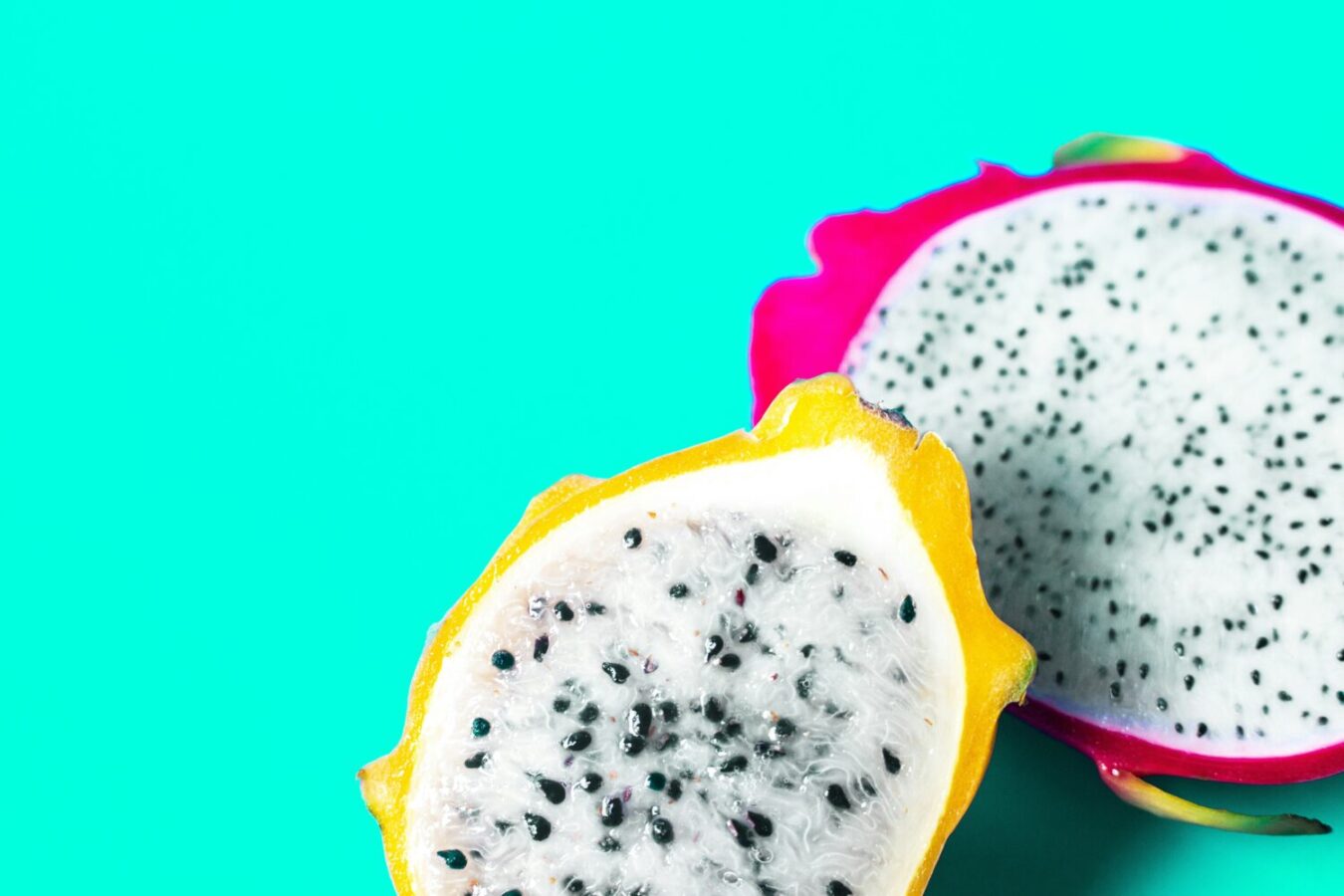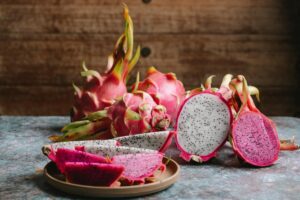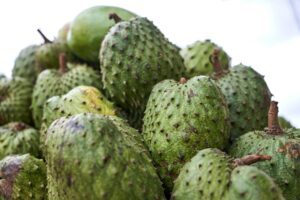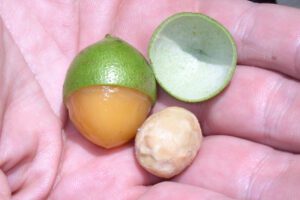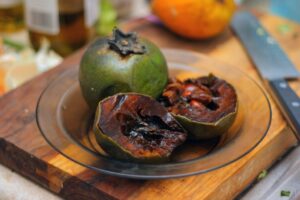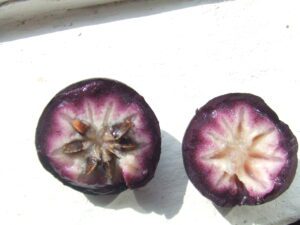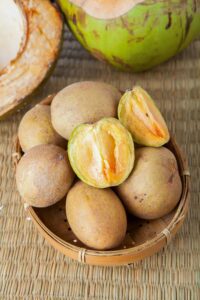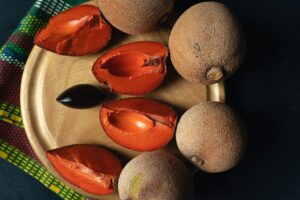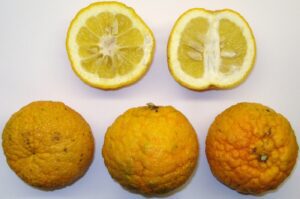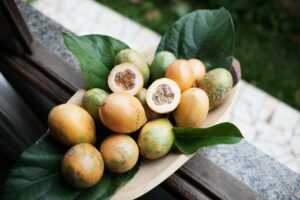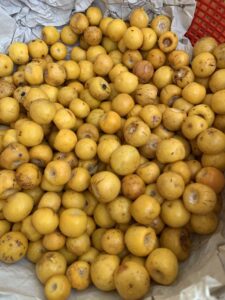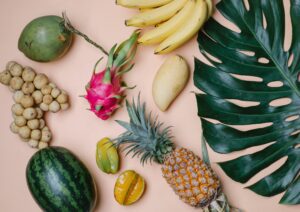The unique flavors of traditional Mexican food come from the labor of expert farmers in charge of growing thousands of fruits, vegetables, and spices that feed not only the 32 states in Mexico but the entire world.
Source: Eating With Carmen Food Tours
On one side, the Michoacan avocado represents the fruit with the highest production and export worldwide, and near Uxmal in Yucatán, tons of the finest creole cacao in Mexico are grown annually by the hundreds.
Because the Mayans planted fruit trees even in the most remote jungles, the Yucatan Peninsula is a blessed land with fruit seasons all year round.
In addition to taking advantage of these fruits’ delicious and unique flavor for ice creams, desserts, traditional dishes, and refreshing drinks, many natural properties are also considered, making them an essential part of the Mexican diet.
Locals and tourists alike visit local markets, street stalls, and vendor carts to try many of these delicious exotic fruits. Eating With Carmen Food Tours offers different tours where you can try a wide variety of exotic fruits from the region, without a doubt, one of the favorite stops for foodies!
Keep scrolling to discover some of the favorite tropical fruits of local and foreign foodies alike:
PITHAYA
English: Dragon Fruit
Mayan: Wo, Woob, Bakel
Photo by Any Lane
Its English name refers to how the plant intertwines itself in trees in the same way as the immense mythological animal of Chinese culture, where it originally comes from. The pitahaya is shaped like an elongated ovoid, the skin has hard, sharp thorns that come off easily, and it has a green color that turns yellow or pink. Usually, if the pulp is white, it provides a sweet and refreshing flavor, but when it looks purple or pink, it resembles the flavor of a beet.
Composed mainly of water, dragon fruit contains important minerals such as iron, calcium, phosphorus, and vitamins B1, B2, B3, and C, perfect for boosting the immune system.
Pitaya also contains antioxidant properties, combats the risk of suffering from chronic degenerative and cardiovascular diseases, and due to its low caloric profile it will be one of your best allies for losing weight. The small black seeds found in 60% of the pulp improve the intestinal process, prevent constipation, and reduce the risk of suffering from arrhythmias, in addition to improving the functioning of the heart.
GUANABANA
English: Soursop
Mayan: Takob
Photo by Xavier Messina
Although in ancient Mayan texts, the name of this species appears several times, curiously, there isn’t a lot of evidence that Mayans consumed it before the arrival of the Spanish.
The soursop is part of the large family of the Annona species and together with the saramuyo, they are highly appreciated fruits in the south of the region due to their natural properties. This fruit usually grows in tropical and humid areas. The natural distribution area of soursop covers the tropical region of southern Mexico, Central America, northern South America, and the Caribbean islands.
In appearance, soursop is a fruit with scaly skin with small thorns that when ripe obtains a characteristic green color and inside has a creamy white pulp with black seeds.
The pulp is used to prepare fresh water and ice cream, but in addition to its sweet and refreshing flavor, it has antioxidant properties and is rich in phosphorus, iron, and calcium. The tea and the oil obtained from the leaves are known to be a great option to prevent conditions such as cancer, high blood pressure, constipation, fatigue, diabetes, colds, heart disease, and muscle pain, among many others.
HUAYA
English: Spanish lime
Mayan: Wayúum
Source: Wikipedia Commons
By far, one of the favorite fruits of Yucatecans, who enjoy peeling them and preparing them with lime and chile and then keeping them in their mouths to extract the flavor.
The season starts from June to August and you can find two types of huaya. The native or Indian and the Cuban. The peel of the native is softer and velvety, decomposes more quickly, and has a sweeter flavor. In the Cuban huaya, the peel is harder and has a more acidic flavor. When removing its thin green shell, the huaya reveals a pulp of a peculiar color between pink and orange which covers a large seed.
They are 85% water and are a rich source of carbohydrates, vitamins, minerals, amino acids, potassium, iron and unsaturated fatty acids. The tea from its leaves activates the immune system and prevents the proliferation of bacteria. It also serves to calm nerves and fever, and as a gargle, it cures throat infections. In syrup, it can cure diarrhea and has deworming effects. As if that were not enough, they also kill fleas and scare away bats.
THE ZAPOTE FAMILY
The variety of species in the zapote family, native to Mesoamerica, offers fruits of unique colors and flavors, seeds with shades similar to the large trees where they grow, and each species, is tastier than the other. The word zapote is of Nahuatl origin, which comes from “tzapotl” and means “sweet-tasting fruit”.
ZAPOTE NEGRO
English: chocolate pudding fruit, black soapapple
Mayan: Ta’uch
It’s a dark green fruit almost black on the outside, while inside it has a sweet black-brown pulp that It’s soft like mousse and has sweet notes, but its true appeal is hidden in its nutritional and medicinal properties since it is rich in carbohydrates and vitamins A and C. These vitamins are great aids in skin regeneration as well as prevention of colds.
In Mexican cuisine, this fruit is mixed with orange juice and sugar and turned into a typical Mexican sweet.
Source: Wikipedia Commons
CAIMITO
English: Star apple
Mayan: Ni keh
This version of the Zapote looks like a small ball known by its thick purple-green skin, it can be easily peeled to reveal its white, sweet, and juicy pulp. It is a source of vitamins such as A, C, B, and niacin. It has essential minerals such as calcium, phosphorus, and iron, among others.
Source: Wikipedia Commons
CHICOZAPOTE
English: Sapodilla or soapapple
Mayan: Sak Ya’
Small and sweet fruit comes from the tree commonly called the “gum tree” from which the latex used to make… yes, chewing gum is extracted. Wood is used to build houses, piers, sleepers, posts, furniture, beams, and saddles. Sapodilla is an effective remedy for reducing fever and a rich source of fiber and antioxidants.
Photo by Riki Risnandar
MAMEY
English: Red Mamey
Mayan: Chakal Ha’as
It’s distinguished by being an oval-shaped fruit, with a thin shell with a rough texture, its pulp is reddish and the flavor is sweet. This fruit is characterized by being 75 percent water and having a high content of carbohydrates, vitamin A, vitamin C, calcium, iron, and phosphorus. Its peculiar color is due to its high content of carotenes, which have an antioxidant effect.
Photo by Wil Carranza
NARANJA AGRIA
English: Sour Orange
Mayan: Ts’uuts’ Pak’aal
Source: Wikipedia Commons
The sour orange tree, native to Southeast Asia, was brought to the Yucatan Peninsula centuries ago and little by little it positioned itself as a cultural icon.
This unique fruit is more than just an orange, the peel has a rough appearance, it normally changes to a greenish-yellowish color when it is ripe, but the fruit is also green. Unlike other oranges, it is anything but sweet as it is characterized by a bitter and acidic, but at the same time, refreshing flavor.
It adds a unique flavor to several typical dishes, especially the famous Cochinita Pibil Yucateca. The juice of this fruit is used to marinate and tenderize meats, giving them a distinctive and delicious flavor. Its acidity and bitterness create a balance that enhances the flavors of the region’s rich culinary heritage.
It is also used for its diversity of medicinal properties since sour orange juice helps improve digestion, reduces inflammation, and stimulates the immune system. Traditional healers have used it for centuries as a mild sedative to treat various ailments, and anxiety and even relieve hives caused by mosquito bites.
MARACUYA
English: Passion Fruit
Mayan: Poch’il
Photo by Marcello Aquino
Passion fruit is native to Central America but indigenous people and conquerors who came to inhabit Quintana Roo have cultivated it thanks to the climate and soil which are perfect for its harvest. This exotic fruit comes from a wild tree in a tropical climate characterized by being a vine that easily expands over any surface.
The yellow-skinned passion fruit commonly grows in Mexico and the purple variety can be found more in Central America. When the fruit is ripe, the peel obtains a wrinkled texture as if it were dry, it has a bittersweet flavor and, at the same time, great aroma. You can see many black seeds and the pulp has a gelatinous consistency of intense yellow color.
Passion fruit provides Vitamin A and vitamin C to our body, and the seeds provide fiber, which reduces constipation and cholesterol. It serves as an antioxidant source and its high content of carbohydrates, minerals, and proteins strengthens our immune system, as well as our bones and teeth. It provides high energy values due to its fat content, helps the body recover from infections more quickly, and reduces menstrual pain.
NANCE
English: Golden Spoon
Mayan: Chi’
Source: Wikipedia Commons
The importance of nance in the region of Yucatan and Quintana Roo is depicted in the Popol Vuh, the sacred book of the Mayans, in which there is a passage that narrates how a vain bird fed on the fruits of a large nance tree.
This small, round fruit is yellow with orange tones, with a strong aroma and abundant sweet and sour pulp surrounding an even smaller seed.
Nance is loaded with minerals and vitamins such as vitamin K, vitamin C, folic acid, and manganese. It contains vitamin E that acts as an anti-aging nutrient in the body and skin.
Its precious fruits are mainly found around September and are usually consumed as a fresh snack for children and adults.
Photo by Any Lane
The tropical fruits of Mexico are an essential part of our diet and our culture, whether you try them in fresh waters, flavored margaritas, ice pops, or with a little chili powder and lemon, they will always be a great snack.
- Abbey

